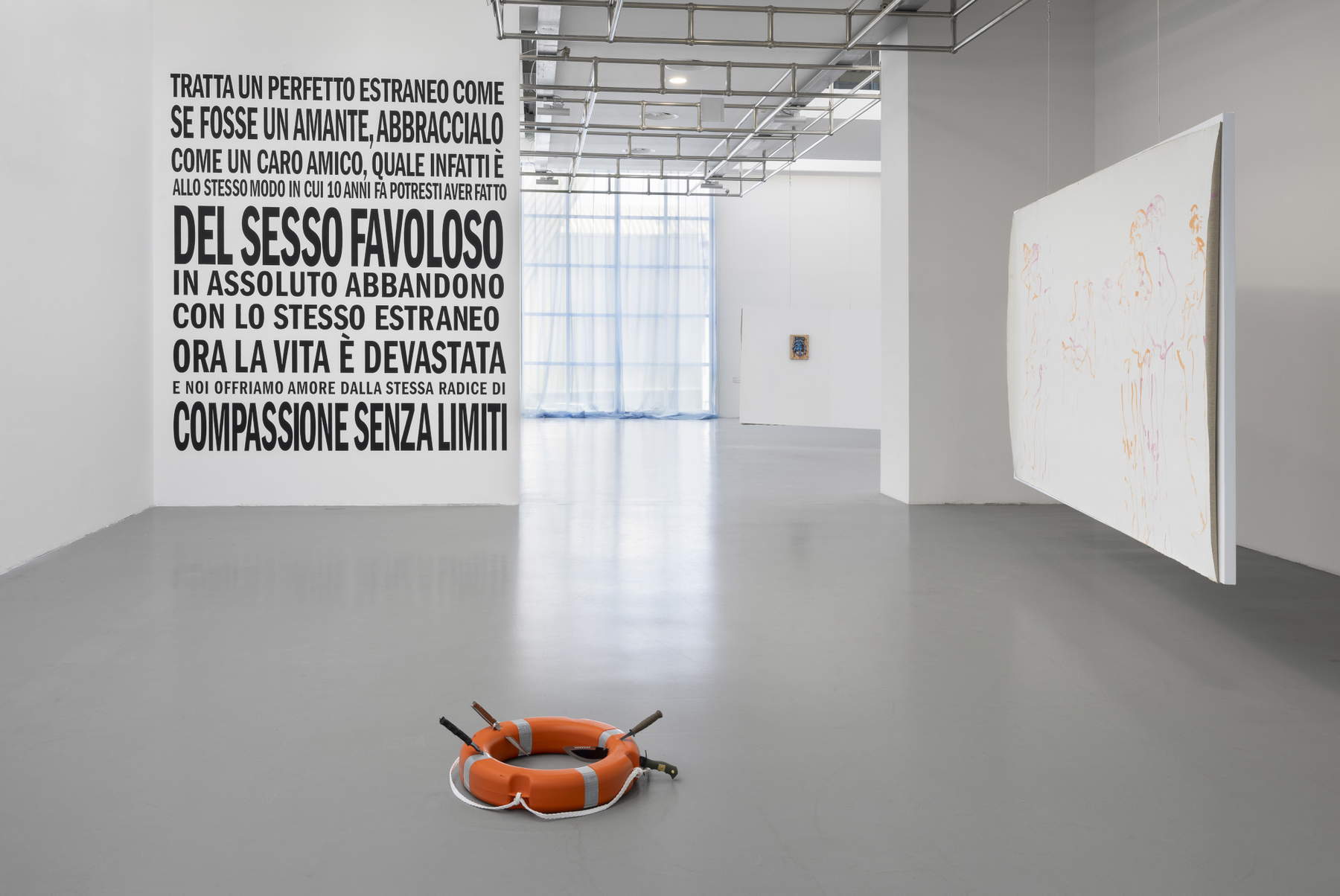The Luigi Pecci Center for Contemporary Art in Prato is hosting from October 4, 2025 to March 1, 2026 the exhibition LIVE. Art and Affects, HIV-AIDS in Italy. 1982-1996, curated by Michele Bertolino. This is the first institutional exhibition to reconstruct and restore the memory of Italian artists involved in the HIV-AIDS crisis. The exhibition interweaves artworks, poetic texts, soundscapes, videos and archival materials together with personal memories, outlining a possible reconnaissance covering the years from 1982 to 1996: from the detection of the first case of overt AIDS in Italy to the introduction of antiretroviral therapies.
The exhibition, supported by Intesa Sanpaolo, takes place in the historic spaces of the Pecci Center, which had already promoted exhibition, cultural and social activities to counter the stigma and misinformation about AIDS between 1992 and 1994. The museum’s permanent exhibition, Eccentrica, also preserves Commemuro (1993) by Francesco Torrini, a work in memory of friends and acquaintances who died of AIDS. The exhibition was made possible through collaboration with a scientific committee of curators, archivists and activists committed to reinterpreting that crisis in light of the present.
The exhibition opens with a film, commissioned for the occasion by Roberto Ortu and made with the contribution of Candy. In the filmic work, poems by Dario Bellezza, Massimiliano Chiamenti, Nino Gennaro, Ottavio Mai, La Nina, Marco Sanna and Pier Vittorio Tondelli-authors who lived with HIV and wrote about it in their texts-are read by artists, activists and actresses. The words find new life in the fabric of contemporary everyday life, offering a reflection on love and affection that questions: how do we love together?



The archive forms the backbone of the project. Constructed with Valeria Calvino, Daniele Calzavara and the White Rabbits, it collects posters, articles, documents, videos and sound tracks that reconstruct the Italian historical, social and political and cultural context between 1982 and 1996. The materials are displayed on large mobile bulletin board tables, suggesting the idea of a narrative that is always recomposable. Alongside the historical documents emerge contemporary readings by Emmanuel Yoro and Tomboys Don’t Cry, which highlight voids and silences.
In dialogue with these traces are the works of Italian artists, testimonies of lived experiences that restore the complexity of those years. Sometimes shouted, other times intimate and whispered, they interweave aesthetic research, political activism, personal experiences and philosophical reflection. These are flanked by works by international artists who had a strong impact on Italy between 1982 and 1996: the posters of Gran Fury, presented at the 1990 Biennale and never exhibited again in Italy, are re-proposed together with the works of Keith Haring; Felix Gonzalez-Torres ’s blue organza curtains (presented at Castello di Rivara in 1991) dialogue with the works of David Wojnarowicz and Walter Robinson, exhibited in Milan by Corrado Levi as early as 1984.
Three monographic rooms are dedicated to Nino Gennaro, Francesco Torrini and Patrizia Vicinelli, figures who combine poetry, body and image in a personal quest. Vicinelli gives physicality to the word, transforming it into a fragile and combative body, capable of longing for freedom. Gennaro addresses the theme of the right to housing and the fight against the Mafia, interweaving verb-visual poetry, theater and collage with reflections on love, joy and mutual recognition. Torrini, connected to the Florentine community of the 1980s and aware of international experiences, recounts the body as a place of memory, traversed by a secular spirituality. In all, HIV-AIDS is not only the theme of the works but a lens through which to read life, vulnerability and the possibility of responding with beauty and relationship.
The installation, designed by Giuseppe Ricupero, develops on white tones and builds a path among stories and voices that are often marginalized. Movable structures and devices dedicated to each artist transform the museum space into a place that recalls domestic intimacy, placing relationships, bodies and affective geographies at the center.



The exhibition raises crucial questions: how to experience love and joy when all around is darkness? What happens to anger and hope when all seems lost? How do we build alliances and preserve meaning in life in a condition of widespread vulnerability? The exhibition looks at the years of the HIV-AIDS crisis in Italy as a generative period, in which affection and solidarity became political tools, forms of care and resistance. It is a collective narrative, a choral portrait of a generation that continued to live through words, images, bodies, desires and utopias that still resonate today.
The exhibition is accompanied by a two-volume publication published by Axis Axis: LIVE. Archive, which brings together a rich iconographic and chronological apparatus of works and documents, and LIVE. Reader, which features ten previously unpublished essays along with an anthology of poetic texts and letters by the artists in the exhibition.
Images: LIVE. Art and affect, HIV and AIDS in Italy. 1982 - 1996. Prato, Luigi Pecci Center for Contemporary Art, 2025. Photo by Andrea Rossetti.
 |
| Art and HIV-AIDS in Italy between 1982 and 1996: an exhibition on the subject at the Pecci Center in Prato |
Warning: the translation into English of the original Italian article was created using automatic tools. We undertake to review all articles, but we do not guarantee the total absence of inaccuracies in the translation due to the program. You can find the original by clicking on the ITA button. If you find any mistake,please contact us.